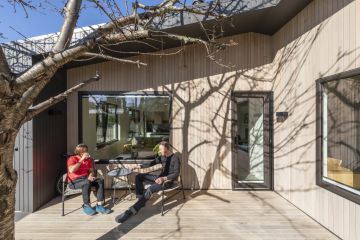Inside Australia's first aircrete dome home, built by hand
Cath Wild knows every centimetre of her home, the way an artist knows a sculpture made with their own hands.
She’s just finished building Australia’s first council-approved aircrete house, near the little village of Flaxton in the Sunshine Coast hinterland.
Wild, 52, made the aircrete – a material produced by a combination of cement, dishwashing liquid and water – on-site and moulded it into 6000 bricks. She then used these bricks to build four dome-shaped rooms interconnected by arches.

It took three years to complete. Wild started the journey with an empty block of land and the dream of building a sustainable house, inspired by Steve Areen’s terracotta dome in Thailand.
“It was like a marathon,” she says of getting through the 90-square-metre project which is now one of the biggest aircrete domes in the world. “You get to a certain stage and you’re buggered, but as long as you keep putting one foot in front of the other, eventually you’re going to get there.”

The home’s aircrete brick walls have been reinforced with fibreglass mesh and mortar. Now that the dome’s exterior is painted white, its unique organic shape looks striking against the lush background of the rainforest.
Inside, there’s a kitchen and living room inside the largest of the four domes, which is 4.6 metres high and seven metres wide, and lit by a skylight. Two smaller domes are bedrooms, and another is a bathroom and laundry.
Wild loves the home’s flow, and has opted not to put doors between the rooms. She says from her first night there the calm vibe had her sleeping like a baby. “It’s really a very nurturing, peaceful kind of sleep … there’s just an energy in that space that’s so calming.”

Wild, an artist, learned how to make aircrete at a workshop in 2020 and raves about its benefits: it’s user-friendly, even for inexperienced builders, has good thermal and sound properties, and is pest proof. It’s also cheap enough that Wild built her new home without having to take out a mortgage.
She estimates the whole home cost $130,000, but a good portion of that went towards council fees, excavation works and the concrete slab. It took two years to get council approval before starting the build, which has a septic system but is connected to the grid.
You can see evidence of Wild’s artistic flair throughout the house, including cedar shelving and bedheads she carved, and stained glass windows crafted for the spa hut, where a hot tub awaits.

Understanding how to build with aircrete is an evolving body of knowledge. Wild made some discoveries along the way that will smooth the process for future “domies”, particularly how to eliminate annoying crazing (fine cracks in the concrete) that has haunted dome builders for years.
It’s an issue that arose after putting on the render, which expands and contracts at a different rate to the aircrete under it, resulting in potential leaking.
“I’ve fixed it with a thermal coating of paint that reduces the temperature by 30 degrees on the outer coat, so you don’t get those differential rates of expansion and contraction, if we’re using engineering speak. And there’s no crazing,” Wild says.

There were plenty of other hurdles to overcome, from material shortages to the rain and heat of the Sunshine Coast and some major life changes.
Wild started the build with her partner, but went through a divorce, difficult health problems and ongoing financial stress.
“Me being me, I threw myself into making stained glass for a couple of months,” she says. “That was my therapy. I learnt how to do that and I’ve incorporated it into the dome.”

Wild crossed the finish line with the build after winning some funding through Airbnb’s OMG competition, a worldwide contest to fund sustainable homes. It provided an “influx of cash and energy” that went towards new windows, stone benchtops and rock retaining walls that Wild says she couldn’t have afforded otherwise.
“Now I’m sitting in this reflective calm space, after the last three years on a roller coaster, and actually starting to relax and recognise the achievement and the significance of what I’ve done,” she says.
The dome home is available for bookings on Airbnb for the next year (a condition of winning the OMG competition) but Wild will stay there between bookings.
She looks forward to having it all to herself after that to fully reap the rewards. “I know I’m going to love living in it.”
We recommend
We thought you might like
States
Capital Cities
Capital Cities - Rentals
Popular Areas
Allhomes
More










